A Review on Experimental and Numerical Investigations of Jet Impingement Cooling Performance with Nanofluids
Abstract
1. Introduction
2. Introduction to Nanofluids
2.1. Nanofluid Preparation Methods
2.2. Classification of Nanofluids
2.2.1. Metal-Based Nanofluids
2.2.2. Metal Oxide-Based Nanofluids
2.2.3. Carbon-Based Nanofluids
2.2.4. Hybrid Nanofluids
2.3. Nanofluid Stabilization Methods
2.3.1. Magnetic Stirrer
2.3.2. Surfactants
2.3.3. Sonification
3. Flow Characteristics of Jet Impingement
4. Nanofluids in Jet Impingement
4.1. Experimental Approach
4.1.1. The Literature on Conventional Impinging Jets
4.1.2. The Literature on Swirling Impinging Jets
4.2. Numerical Approach
4.2.1. Single-Phase Model
4.2.2. Two-Phase Model
5. Conclusions and Future Direction
- Most researchers use a two-step method for preparation of nanofluids as it is cheaper and less complicated when compared to a single-step method;
- The stability of nanofluids remains one of the biggest challenges in their preparation. Although methods to enhance stability, such as surfactants and sonification are introduced, the optimum concentration of surfactant and optimum sonification time are undetermined;
- Limited studies have looked into the combination of hybrid nanofluids and jet impingement. Hence, efforts can be made to find out the effects of such combinations;
- Extensive research on the effect of impinging surfaces such as those with flat, convex or concave shape is required to further understand their jet impinging capabilities;
- Although application of nanofluids could enhance the heat transfer performance of jet impingement systems, agglomeration or particle sedimentation is still a challenge. Thus, more research is required to mitigate or eliminate such restrictions and to be able to deploy a better accurate prediction model for future reference;
- The crucial parameters that affect the heat transfer performance of a nanofluid jet impinging system include the geometrical shape of the nozzle, number of jet nozzles, ratio of jet-to-target distance (H/D), twist ratio (y/w) for SIJs and type of jet impinging system (confined, unconfined or submerged). The implementation of nanofluids in jet impingement adds a few influencing parameters affecting the heat transfer performance, such as the type of nanofluid, Reynolds number, type of flow (laminar or turbulent), nanoparticle size, shape and concentration;
- Few researchers have investigated nanofluids in swirling impinging jets (SIJs). The swirling effect created the tangential velocity which enhanced the heat transfer performance when compared to conventional impinging jets (CIJs). SIJs also have a higher entrainment rate and impinging area;
- In numerical studies, two common approaches were used to obtain a numerical solution, which are the single-phase model and the two-phase model. On comparison, most researchers utilize the single-phase model to save computational time. Computational time is higher in the two-phase model because of the introduction of additional parameters such as slip velocity and other forces, which were neglected in the single-phase model.
Author Contributions
Funding
Data Availability Statement
Acknowledgments
Conflicts of Interest
References
- Miao, L. How to Improve the Reliability of Electronic Components. J. Electron. Res. Appl. 2017, 1, 23–25. [Google Scholar] [CrossRef]
- Rupprecht, C. Cooling Device for Use in Heat Dissipation Associated with Electronic Components Technical. U.S. Patent Application Number: 16/043,459, 31 January 2019. [Google Scholar]
- Da Silva Dias, A.; Candido, D.B.; Almeida, A.P.; Alves, J.A. Cooling methods design for power electronics converters. In Proceedings of the 14th Brazilian Power Electronics Conference, COBEP 2017, Juiz de Fora, Brazil, 19–22 November 2017; Volume 2018, pp. 1–6. [Google Scholar]
- Abdullahi, B.; Al-dadah, R.K.; Mahmoud, S. Thermosyphon Heat Pipe Technology. In Recent Advances in Heat Pipes; Wael, I., Aly, A., Eds.; IntechOpen: London, UK, 2019; pp. 2–20. [Google Scholar]
- Kadam, S.T.; Kumar, R. Twenty first century cooling solution: Microchannel heat sinks. Int. J. Therm. Sci. 2014, 85, 73–92. [Google Scholar] [CrossRef]
- Pourkiaei, S.M.; Ahmadi, M.H.; Sadeghzadeh, M.; Moosavi, S.; Pourfayaz, F.; Chen, L.; Pour Yazdi, M.A.; Kumar, R. Thermoelectric cooler and thermoelectric generator devices: A review of present and potential applications, modeling and materials. Energy 2019, 186, 115849. [Google Scholar] [CrossRef]
- Zuckerman, N.; Lior, N. Jet impingement heat transfer: Physics, correlations, and numerical modeling. Adv. Heat Transf. 2006, 39, 565–631. [Google Scholar] [CrossRef]
- Abdelrehim, O.; Khater, A.; Mohamad, A.A.; Radwan, A. Two-phase simulation of nanofluid in a confined single impinging jet. Case Stud. Therm. Eng. 2019, 14, 1–3. [Google Scholar] [CrossRef]
- Dixit, T.; Ghosh, I. Review of micro- and mini-channel heat sinks and heat exchangers for single phase fluids. Renew. Sustain. Energy Rev. 2015, 41, 1298–1311. [Google Scholar] [CrossRef]
- Sofiah, A.G.N.; Samykano, M.; Pandey, A.K.; Kadirgama, K.; Sharma, K.; Saidur, R. Immense impact from small particles: Review on stability and thermophysical properties of nanofluids. Sustain. Energy Technol. Assess. 2021, 48, 101635. [Google Scholar] [CrossRef]
- Sundar, L.S.; Sharma, K.V.; Singh, M.K.; Sousa, A.C.M. Hybrid nanofluids preparation, thermal properties, heat transfer and friction factor—A review. Renew. Sustain. Energy Rev. 2017, 68, 185–198. [Google Scholar] [CrossRef]
- Sridhara, V.; Satapathy, L.N. Effect of Nanoparticles on Thermal Properties Enhancement in Different Oils-A Review. Crit. Rev. Solid State Mater. Sci. 2015, 40, 399–424. [Google Scholar] [CrossRef]
- Esfahani, M.R.; Languri, E.M.; Nunna, M.R. Effect of particle size and viscosity on thermal conductivity enhancement of graphene oxide nanofluid. Int. Commun. Heat Mass Transf. 2016, 76, 308–315. [Google Scholar] [CrossRef]
- Asadi, A.; Pourfattah, F.; Miklós Szilágyi, I.; Afrand, M.; Żyła, G.; Seon Ahn, H.; Wongwises, S.; Minh Nguyen, H.; Arabkoohsar, A.; Mahian, O. Effect of sonication characteristics on stability, thermophysical properties, and heat transfer of nanofluids: A comprehensive review. Ultrason. Sonochem. 2019, 58, 104701. [Google Scholar] [CrossRef] [PubMed]
- Babar, H.; Sajid, M.U.; Ali, H.M. Viscosity of hybrid nanofluids: A critical review. Therm. Sci. 2019, 23, 1713–1754. [Google Scholar] [CrossRef]
- Yu, W.; France, D.; Choi, S.; Routbort, J. Review and Assessment of Nanofluid Technology for Transportation and other Applications; Argonne National Lab. (ANL): Argonne, IL, USA, 2007. [Google Scholar]
- Yu, W.; France, D.M.; Routbort, J.L.; Choi, S.U.S. Review and comparison of nanofluid thermal conductivity and heat transfer enhancements. Heat Transf. Eng. 2008, 29, 432–460. [Google Scholar] [CrossRef]
- Sun, B.; Zhang, Y.; Yang, D.; Li, H. Experimental study on heat transfer characteristics of hybrid nanofluid impinging jets. Appl. Therm. Eng. 2019, 151, 556–566. [Google Scholar] [CrossRef]
- Ali, H.M.; Babar, H.; Shah, T.R.; Sajid, M.U.; Qasim, M.A.; Javed, S. Preparation Techniques of TiO2 Nanofluids and Challenges: A Review. Appl. Sci. 2018, 8, 587. [Google Scholar] [CrossRef]
- Beicker, C.L.L.; Amjad, M.; Bandarra Filho, E.P.; Wen, D. Experimental study of photothermal conversion using gold/water and MWCNT/water nanofluids. Sol. Energy Mater. Sol. Cells 2018, 188, 51–65. [Google Scholar] [CrossRef]
- Li, D.; Fang, W.; Feng, Y.; Geng, Q.; Song, M. Stability properties of water-based gold and silver nanofluids stabilized by cationic gemini surfactants. J. Taiwan Inst. Chem. Eng. 2019, 97, 458–465. [Google Scholar] [CrossRef]
- Graves, J.E.; Latvytė, E.; Greenwood, A.; Emekwuru, N.G. Ultrasonic preparation, stability and thermal conductivity of a capped copper-methanol nanofluid. Ultrason. Sonochem. 2019, 55, 25–31. [Google Scholar] [CrossRef]
- Wongcharee, K.; Chuwattanakul, V.; Eiamsa-ard, S. Heat transfer of swirling impinging jets with TiO2-water nanofluids. Chem. Eng. Process. Process Intensif. 2017, 114, 16–23. [Google Scholar] [CrossRef]
- Wongcharee, K.; Chuwattanakul, V.; Eiamsa-ard, S. Influence of CuO/water nanofluid concentration and swirling flow on jet impingement cooling. Int. Commun. Heat Mass Transf. 2017, 88, 277–283. [Google Scholar] [CrossRef]
- Al-Zuhairy, R.C.; Kareem, Z.S.; Abdulhadi, A.A. Al2O3-water nanofluid heat transfer enhancement of a twin impingement jet. Case Stud. Therm. Eng. 2020, 19, 100626. [Google Scholar] [CrossRef]
- Lv, J.; Chang, S.; Hu, C.; Bai, M.; Wang, P.; Zeng, K. Experimental investigation of free single jet impingement using Al2O3-water nanofluid. Int. Commun. Heat Mass Transf. 2017, 88, 126–135. [Google Scholar] [CrossRef]
- Yu, W.; Xie, H.; Chen, L.; Li, Y. Investigation of thermal conductivity and viscosity of ethylene glycol based ZnO nanofluid. Thermochim. Acta 2009, 491, 92–96. [Google Scholar] [CrossRef]
- Sarafraz, M.M.; Hormozi, F.; Nikkhah, V. Thermal performance of a counter-current double pipe heat exchanger working with COOH-CNT/water nanofluids. Exp. Therm. Fluid Sci. 2016, 78, 41–49. [Google Scholar] [CrossRef]
- Xie, H.; Lee, H.; Youn, W.; Choi, M. Nanofluids containing multiwalled carbon nanotubes and their enhanced thermal conductivities. J. Appl. Phys. 2003, 94, 4967–4971. [Google Scholar] [CrossRef]
- Muruganandam, M.; Mukesh Kumar, P.C. Experimental analysis on internal combustion engine using MWCNT/water nanofluid as a coolant. In Proceedings of the Materials Today: Proceedings; Elsevier Ltd.: Amsterdam, The Netherlands, 2020; Volume 21, pp. 248–252. [Google Scholar]
- Hameed, A.; Mukhtar, A.; Shafiq, U.; Khan, M.S.; Rashid, T.; Cornelius, B. Experimental investigation on synthesis, characterization, stability, thermo-physical properties and rheological behavior of MWCNTs-kapok seed oil based nanofluid. J. Mol. Liq. 2019, 277, 812–824. [Google Scholar] [CrossRef]
- Hemmat Esfe, M.; Alirezaie, A.; Rejvani, M. An applicable study on the thermal conductivity of SWCNT-MgO hybrid nanofluid and price-performance analysis for energy management. Appl. Therm. Eng. 2017, 111, 1202–1210. [Google Scholar] [CrossRef]
- Leong, K.Y.; Razali, I.; Ku Ahmad, K.Z.; Ong, H.C.; Ghazali, M.J.; Abdul Rahman, M.R. Thermal conductivity of an ethylene glycol/water-based nanofluid with copper-titanium dioxide nanoparticles: An experimental approach. Int. Commun. Heat Mass Transf. 2018, 90, 23–28. [Google Scholar] [CrossRef]
- Hemmat Esfe, M.; Abbasian Arani, A.A.; Firouzi, M. Empirical study and model development of thermal conductivity improvement and assessment of cost and sensitivity of EG-water based SWCNT-ZnO (30%:70%) hybrid nanofluid. J. Mol. Liq. 2017, 244, 252–261. [Google Scholar] [CrossRef]
- Hemmat Esfe, M.; Esfandeh, S.; Saedodin, S.; Rostamian, H. Experimental evaluation, sensitivity analyzation and ANN modeling of thermal conductivity of ZnO-MWCNT/EG-water hybrid nanofluid for engineering applications. Appl. Therm. Eng. 2017, 125, 673–685. [Google Scholar] [CrossRef]
- Baniamerian, Z.; Mashayekhi, M.; Mehdipour, R. Evaporative Behavior of Gold-Based Hybrid Nanofluids. J. Thermophys. Heat Transf. 2018, 32, 284–291. [Google Scholar] [CrossRef]
- Siricharoenpanich, A.; Wiriyasart, S.; Srichat, A.; Naphon, P. Thermal cooling system with Ag/Fe3O4nanofluids mixture as coolant for electronic devices cooling. Case Stud. Therm. Eng. 2020, 20, 100641. [Google Scholar] [CrossRef]
- Chakraborty, S.; Panigrahi, P.K. Stability of nanofluid: A review. Appl. Therm. Eng. 2020, 174, 115259. [Google Scholar] [CrossRef]
- Chakraborty, S.; Sarkar, I.; Behera, D.K.; Pal, S.K.; Chakraborty, S. Experimental investigation on the effect of dispersant addition on thermal and rheological characteristics of TiO2 nanofluid. Powder Technol. 2017, 307, 10–24. [Google Scholar] [CrossRef]
- Saleh, R.; Putra, N.; Wibowo, R.E.; Septiadi, W.N.; Prakoso, S.P. Titanium dioxide nanofluids for heat transfer applications. Exp. Therm. Fluid Sci. 2014, 52, 19–29. [Google Scholar] [CrossRef]
- Mejia, J.; Valembois, V.; Piret, J.P.; Tichelaar, F.; Van Huis, M.; Masereel, B.; Toussaint, O.; Delhalle, J.; Mekhalif, Z.; Lucas, S. Are stirring and sonication pre-dispersion methods equivalent for in vitro toxicology evaluation of SiC and TiC? J. Nanopart. Res. 2012, 14, 815. [Google Scholar] [CrossRef]
- Xia, G.; Jiang, H.; Liu, R.; Zhai, Y. Effects of surfactant on the stability and thermal conductivity of Al2O3/de-ionized water nanofluids. Int. J. Therm. Sci. 2014, 84, 118–124. [Google Scholar] [CrossRef]
- Yang, L.; Chen, X.; Xu, M.; Du, K. Roles of surfactants and particle shape in the enhanced thermal conductivity of TiO2 nanofluids. AIP Adv. 2016, 6, 4962659. [Google Scholar] [CrossRef]
- Choudhary, R.; Khurana, D.; Kumar, A.; Subudhi, S. Stability analysis of Al2O3/water nanofluids. J. Exp. Nanosci. 2017, 12, 140–151. [Google Scholar] [CrossRef]
- Afzal, A.; Nawfal, I.; Mahbubul, I.M.; Kumbar, S.S. An overview on the effect of ultrasonication duration on different properties of nanofluids. J. Therm. Anal. Calorim. 2019, 135, 393–418. [Google Scholar] [CrossRef]
- Ali, A.R.I.; Salam, B. A review on nanofluid: Preparation, stability, thermophysical properties, heat transfer characteristics and application. SN Appl. Sci. 2020, 2, 1636. [Google Scholar] [CrossRef]
- Choo, K.S.; Kim, S.J. Comparison of thermal characteristics of confined and unconfined impinging jets. Int. J. Heat Mass Transf. 2010, 53, 3366–3371. [Google Scholar] [CrossRef]
- Shukla, A.K.; Dewan, A. Flow and thermal characteristics of jet impingement: Comprehensive review. Int. J. Heat Technol. 2017, 35, 153–166. [Google Scholar] [CrossRef]
- Wai, O.J.; Gunnasegaran, P.; Hasini, H. Effect of Hybrid Nanofluids Concentration and Swirling Flow on Jet Impingement Cooling. Nanomaterials 2022, 12, 3258. [Google Scholar]
- Abo Ras, M.; Wunderle, B.; May, D.; Schacht, R.; Winkler, T.; Rzepka, S.; Michel, B. Limitations and accuracy of steady state technique for thermal characterization of solid and composite materials. In Proceedings of the 2014 15th International Conference on Thermal, Mechanical and Mulit-Physics Simulation and Experiments in Microelectronics and Microsystems (EuroSimE), Ghent, Belgium, 7–9 April 2014. [Google Scholar]
- Modak, M.; Chougule, S.S.; Sahu, S.K. An Experimental Investigation on Heat Transfer Characteristics of Hot Surface by Using CuO-Water Nanofluids in Circular Jet Impingement Cooling. J. Heat Transfer 2018, 140, 012401. [Google Scholar] [CrossRef]
- Lv, J.; Hu, C.; Bai, M.; Zeng, K.; Chang, S.; Gao, D. Experimental investigation of free single jet impingement using SiO2-water nanofluid. Exp. Therm. Fluid Sci. 2017, 84, 39–46. [Google Scholar] [CrossRef]
- Barewar, S.D.; Tawri, S.; Chougule, S.S. Heat transfer characteristics of free nanofluid impinging jet on flat surface with different jet to plate distance: An experimental investigation. Chem. Eng. Process.-Process Intensif. 2019, 136, 1–10. [Google Scholar] [CrossRef]
- Balla, H.H.; Hashem, A.L.; Kareem, Z.S.; Abdulwahid, A.F. Heat transfer potentials of ZnO/water nanofluid in free impingement jet. Case Stud. Therm. Eng. 2021, 27, 101143. [Google Scholar] [CrossRef]
- Kareem, Z.S.; Balla, H.H.; Abdulwahid, A.F. Heat transfer enhancement in single circular impingement jet by CuO-water nanofluid. Case Stud. Therm. Eng. 2019, 15, 100508. [Google Scholar] [CrossRef]
- Sorour, M.M.; El-Maghlany, W.M.; Alnakeeb, M.A.; Abbass, A.M. Experimental study of free single jet impingement utilizing high concentration SiO2 nanoparticles water base nanofluid. Appl. Therm. Eng. 2019, 160, 114019. [Google Scholar] [CrossRef]
- Amjadian, M.; Safarzadeh, H.; Bahiraei, M.; Nazari, S.; Jaberi, B. Heat transfer characteristics of impinging jet on a hot surface with constant heat flux using Cu2O–water nanofluid: An experimental study. Int. Commun. Heat Mass Transf. 2020, 112, 104509. [Google Scholar] [CrossRef]
- Chougule, S.S.; Modak, M.; Gharge, P.D.; Sahu, S.K. MNHMT2016-6629. J. Heat Transf. 2017, 140, 1–8. [Google Scholar]
- Nawani, S.; Subhash, M. A review on multiple liquid jet impingement onto flat plate. In Proceedings of the Materials Today: Proceedings; Elsevier Ltd.: Amsterdam, The Netherlands, 2021. [Google Scholar]
- Deng, X.; Luo, Z.B.; Xia, Z.X.; Gong, W.J. Experimental investigation on the flow regime and impingement heat transfer of dual synthetic jet. Int. J. Therm. Sci. 2019, 145, 105864. [Google Scholar] [CrossRef]
- Hasan, H.A.; Sopian, K.; Jaaz, A.H.; Al-Shamani, A.N. Experimental investigation of jet array nanofluids impingement in photovoltaic/thermal collector. Sol. Energy 2017, 144, 321–334. [Google Scholar] [CrossRef]
- Tie, P.; Li, Q.; Xuan, Y. Heat transfer performance of Cu-water nanofluids in the jet arrays impingement cooling system. Int. J. Therm. Sci. 2014, 77, 199–205. [Google Scholar] [CrossRef]
- Nayak, S.K.; Mishra, P.C.; Parashar, S.K.S. Enhancement of heat transfer by water–Al2O3 and water–TiO2 nanofluids jet impingement in cooling hot steel surface. J. Exp. Nanosci. 2016, 11, 1253–1273. [Google Scholar] [CrossRef]
- Sarkar, I.; Chakraborty, S.; Ashok, A.; Sengupta, I.; Pal, S.K.; Chakraborty, S. Comparative study on different additives with a jet array on cooling of a hot steel surface. Appl. Therm. Eng. 2018, 137, 154–163. [Google Scholar] [CrossRef]
- Yousefi, T.; Shojaeizadeh, E.; Mirbagheri, H.R.; Farahbaksh, B.; Saghir, M.Z. An experimental investigation on the impingement of a planar jet of Al2O3-water nanofluid on a V-shaped plate. Exp. Therm. Fluid Sci. 2013, 50, 114–126. [Google Scholar] [CrossRef]
- Asghari Lafmajani, N.; Ebrahimi Bidhendi, M.; Ashjaee, M. SiO2 nanofluid planar jet impingement cooling on a convex heated plate. Heat Mass Transf. Stoffuebertragung 2016, 52, 2735–2746. [Google Scholar] [CrossRef]
- Hosseinalipour, S.M.; Rostami, A.; Shahriari, G. Numerical study of circumferential temperature difference reduction at the absorber tube of parabolic trough direct steam generation collector by inserting a twisted tape in superheated region. Case Stud. Therm. Eng. 2020, 21, 100720. [Google Scholar] [CrossRef]
- Huang, L.; El-Genk, M.S. Heat transfer and flow visualization experiments of swirling, multi-channel, and conventional impinging jets. Int. J. Heat Mass Transf. 1998, 41, 583–600. [Google Scholar] [CrossRef]
- Salman, S.D.; Kadhum, A.A.H.; Takriff, M.S.; Mohamad, A.B. Experimental and numerical investigations of heat transfer characteristics for impinging swirl flow. Adv. Mech. Eng. 2014, 6, 631081. [Google Scholar] [CrossRef]
- Göktepe, S.; Atalik, K.; Ertürk, H. Comparison of single and two-phase models for nanofluid convection at the entrance of a uniformly heated tube. Int. J. Therm. Sci. 2014, 80, 83–92. [Google Scholar] [CrossRef]
- Mohammadpour, J.; Lee, A. Investigation of nanoparticle effects on jet impingement heat transfer: A review. J. Mol. Liq. 2020, 316, 113819. [Google Scholar] [CrossRef]
- Di Lorenzo, G.; Manca, O.; Nardini, S.; Ricci, D. Laminar confined impinging slot jets with nanofluids on heated surfaces. In Proceedings of the 2011 17th International Workshop on Thermal Investigations of ICs and Systems (THERMINIC), Paris, France, 27–29 September 2011; pp. 183–188. [Google Scholar]
- Manca, O.; Ricci, D.; Nardini, S.; Di Lorenzo, G. Thermal and fluid dynamic behaviors of confined laminar impinging slot jets with nanofluids. Int. Commun. Heat Mass Transf. 2016, 70, 15–26. [Google Scholar] [CrossRef]
- Dutta, R.; Dewan, A.; Srinivasan, B. CFD study of slot jet impingement heat transfer with nanofluids. Proc. Inst. Mech. Eng. Part C J. Mech. Eng. Sci. 2016, 230, 206–220. [Google Scholar] [CrossRef]
- Ahmadi, H.; Moghari, R.M.; Esmailpour, K.; Mujumdar, A.S. Numerical investigation of semi-confined turbulent slot jet impingement on a concave surface using an Al2O3-water nanofluid. Appl. Math. Model. 2016, 40, 1110–1125. [Google Scholar] [CrossRef]
- Datta, A.; Jaiswal, A.; Halder, P. Heat transfer analysis of slot jet impingement using Nano fluid on convex surface. IOP Conf. Ser. Mater. Sci. Eng. 2018, 402, 012098. [Google Scholar] [CrossRef]
- Selimefendigil, F.; Öztop, H.F. Effects of Nanoparticle Shape on Slot Jet Impingement Cooling of a Corrugated Surface with Nanofluids. J. Therm. Sci. Eng. Appl. 2017, 9, 4035810. [Google Scholar] [CrossRef]
- Selimefendigil, F.; Öztop, H.F. Cooling of a partially elastic isothermal surface by nanofluids jet impingement. J. Heat Transfer 2018, 140, 4038422. [Google Scholar] [CrossRef]
- Selimefendigil, F.; Öztop, H.F. Jet impingement cooling and optimization study for a partly curved isothermal surface with CuO-water nanofluid. Int. Commun. Heat Mass Transf. 2017, 89, 211–218. [Google Scholar] [CrossRef]
- Mustafa, K.; Ali, H.M. Numerical investigation of combined effect of nanofluids and multiple impinging jets on heat transfer. Therm. Sci. 2019, 23, 3165–3173. [Google Scholar]
- Fatih, S.; Öztop, H.F. Al2O3-water nanofluid jet impingement cooling with magnetic field. Heat Transf. Eng. 2018, 41, 50–64. [Google Scholar]
- Peng, W.; Lv, J.; Bai, M.; Wang, Y.; Hu, C. A numerical investigation of impinging jet cooling with nanofluids. Nanoscale Microscale Thermophys. Eng. 2014, 18, 329–353. [Google Scholar] [CrossRef]
- Torshizi, E.; Zahmatkesh, I. Comparison between Single-Phase, Two-Phase Mixture and Eulerian-Eulerian Models for the Simulation of Jet Impingement of Nanofluids. J. Appl. Comput. Sci. Mech. 2016, 27. [Google Scholar]
- Babak, Y.-L.; Ramiar, A.; Ranjbar, A.A. Numerical simulation of two phase turbulent flow of nanofluids in confined slot impinging jet. Flow Turbul. Combust. 2016, 97, 571–589. [Google Scholar]
- Huang, J.-B.; Jang, J.-Y. Numerical study of a confined axisymmetric jet impingement heat transfer with nanofluids. Engineering 2013, 5, 60–69. [Google Scholar] [CrossRef]
- Mohammad, Y.; Dinarvand, S.; Yazdi, M.E.; Pop, I. Stagnation-point flow of an aqueous titania-copper hybrid nanofluid toward a wavy cylinder. Int. J. Numer. Methods Heat Fluid Flow 2018. [Google Scholar]
- Mohammadreza, R.; Nademi; Dinarvand, S.; Pop, I. Dual solutions for mixed convective stagnation-point flow of an aqueous silica–alumina hybrid nanofluid. Chin. J. Phys. 2018, 56, 2465–2478. [Google Scholar]
- Dinarvand, S.; Rostami, M.N. An innovative mass-based model of aqueous zinc oxide–gold hybrid nanofluid for von Kármán’s swirling flow. J. Therm. Anal. Calorim. 2019, 138, 845–855. [Google Scholar] [CrossRef]
- Amini, Y.; Mojtaba, M.; Masoud, H.; Gerdroodbary, M.B. Heat transfer of swirling impinging jets ejected from Nozzles with twisted tapes utilizing CFD technique. Case Stud. Therm. Eng. 2015, 6, 104–115. [Google Scholar] [CrossRef]
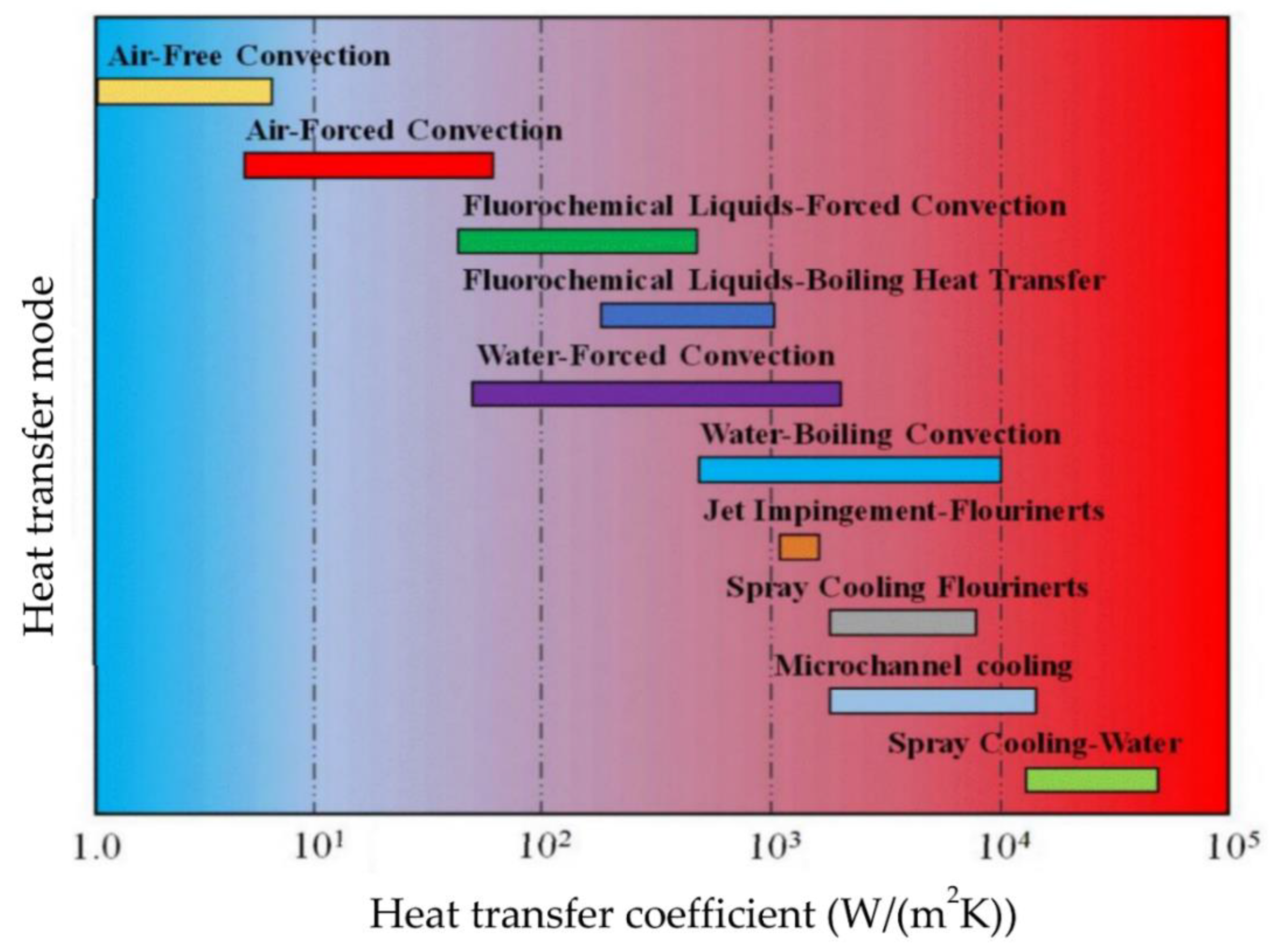

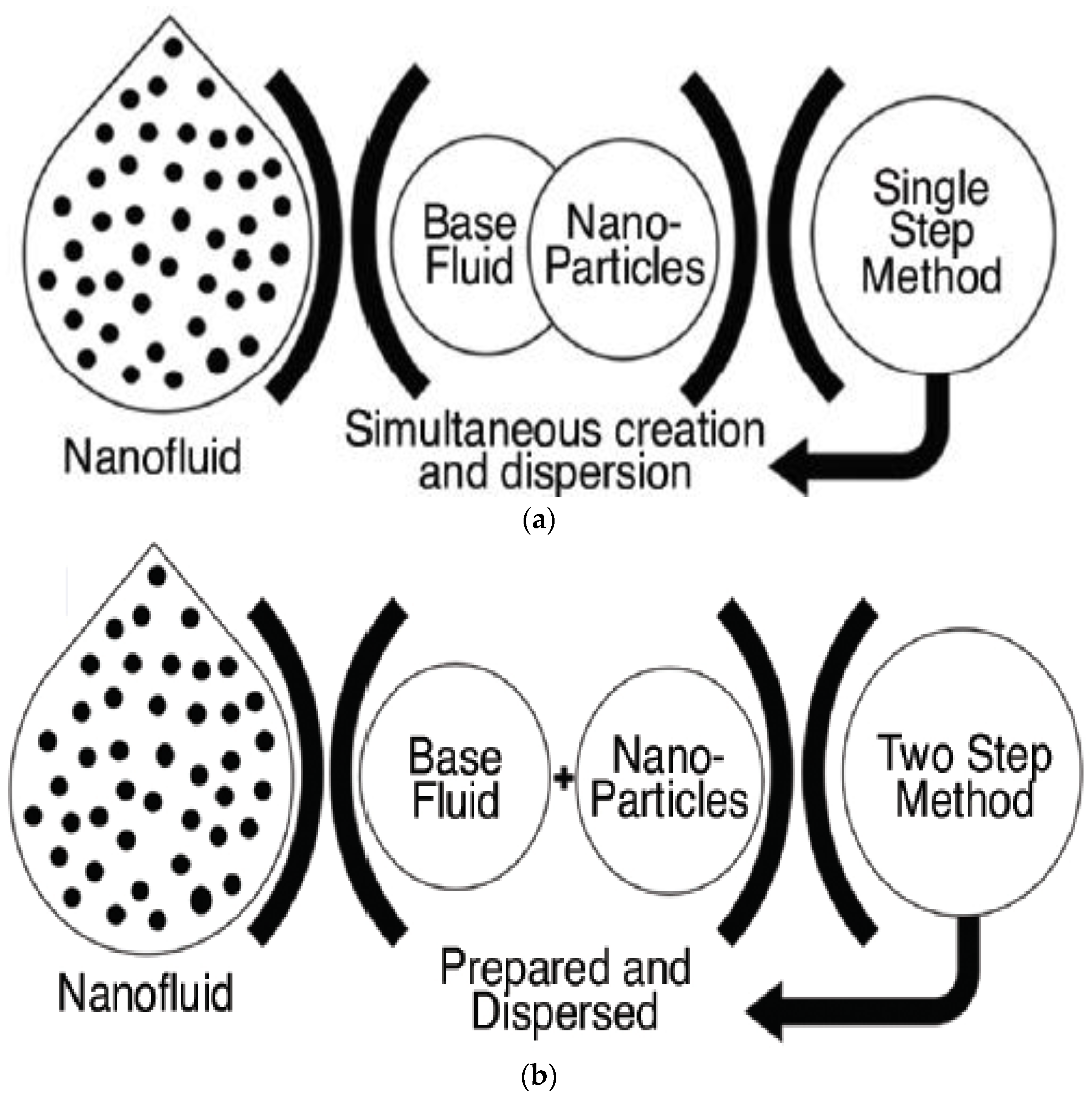
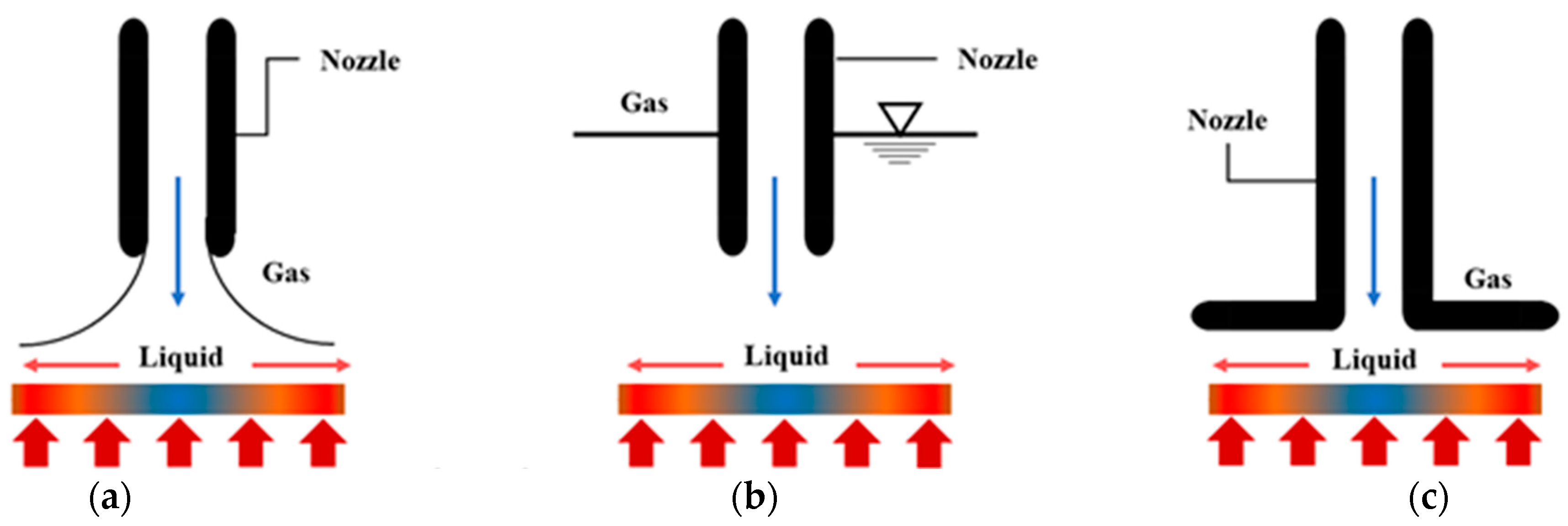
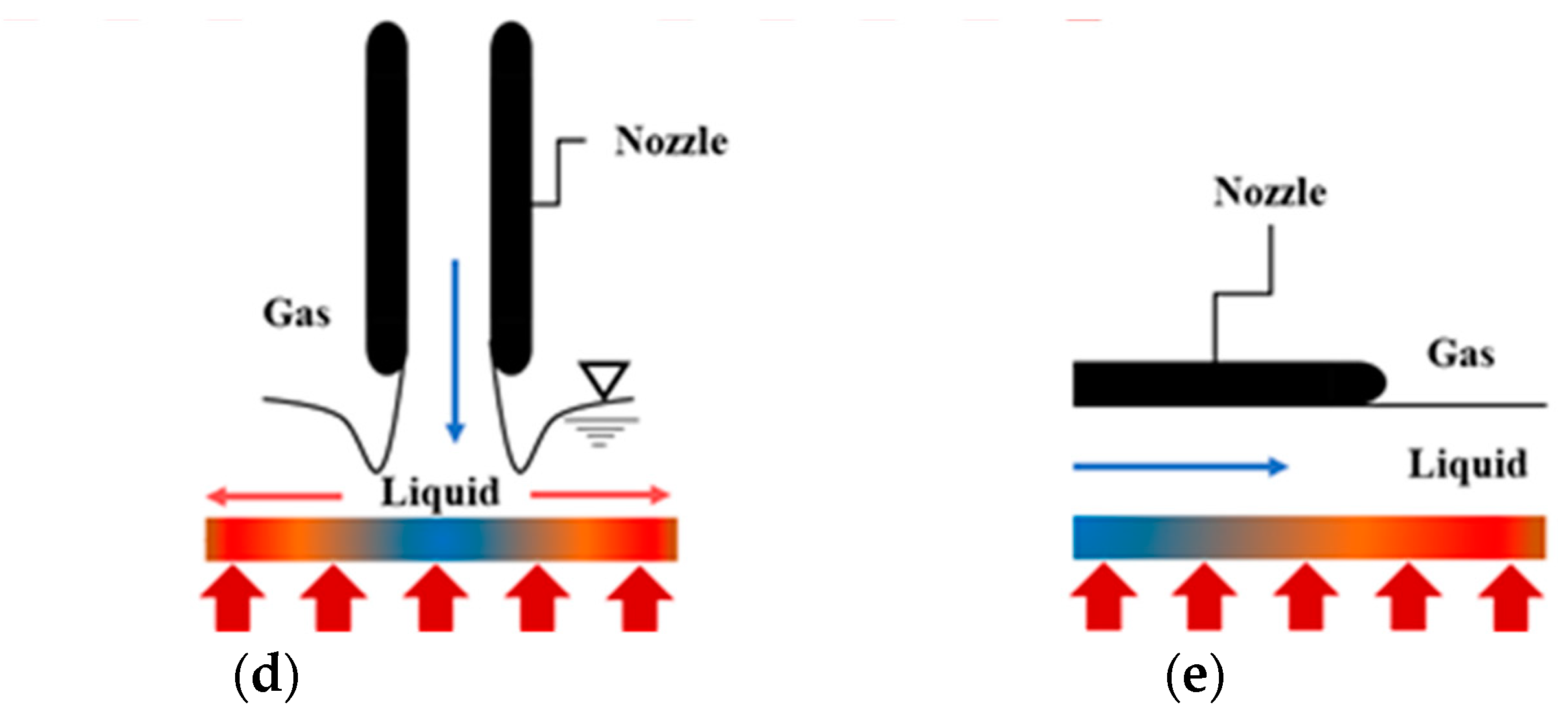
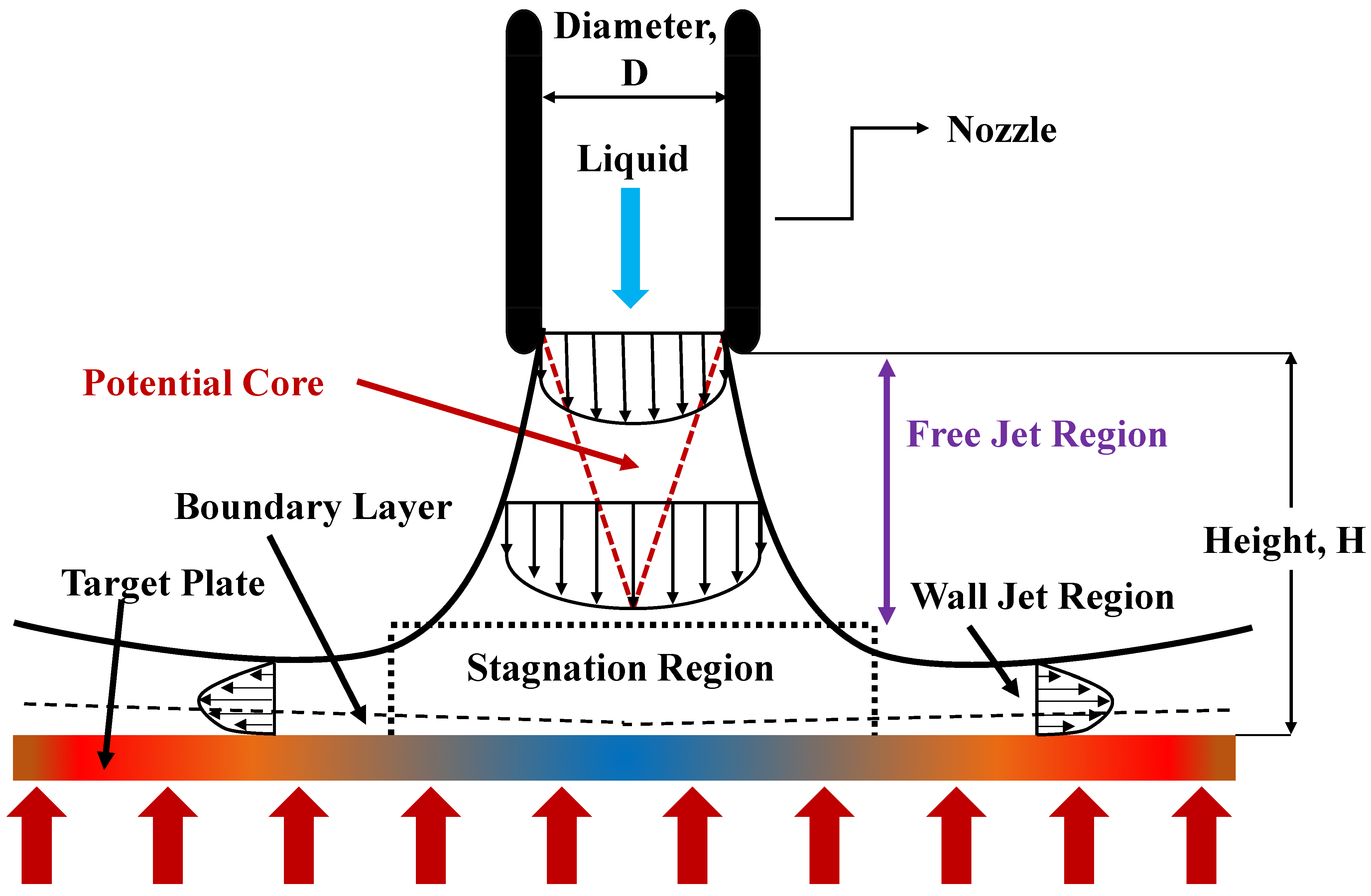
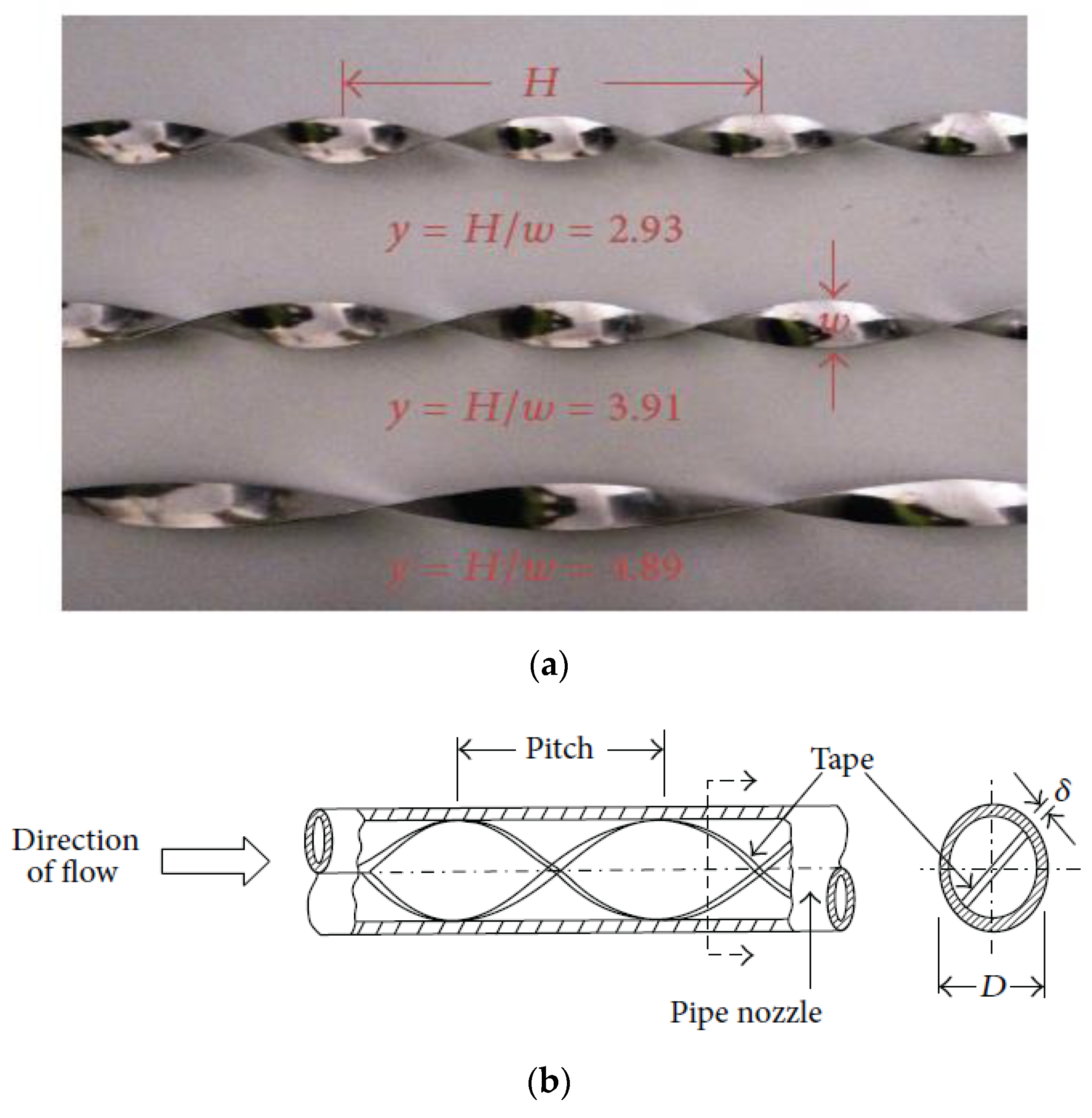
| Cooling Device | Advantages | Disadvantages |
|---|---|---|
| Thermosyphon |
|
|
| Micro-channel heat sink |
|
|
| Thermoelectric |
|
|
| Jet impinging |
|
|
| Particular | One-Step Method | Two-Step Method |
|---|---|---|
| Synthesis process | Simultaneous production of nanoparticles and nanofluid | Production of nanoparticles either chemically or mechanically followed by dispersion of nanoparticles into the base fluid |
| Production scale | Small scale production | Large scale production |
| Cost of production | High cost | Low cost |
| Control on NPs size | Difficult and limited control over the nanoparticle size during the preparation stage | Able to control the nanoparticle size during the preparation stage |
| Particle oxidation | Oxidation of particles does not occur due to the elimination of drying, transportation and storage processes. | No such problem |
| Advantages | Reduced chances of particle agglomeration. More stable nanofluid | Cheaper and more applicable in industry |
| Disadvantages | Residual reactants are left in the nanofluids which might cause problems during application. Can only produce in batch | Prone to agglomeration Constant stabilizing process is needed for long term stability |
| Nanoparticles | Base Fluid | Preparation Method | Nanofluid Sonication Time | Surfactant | Reference |
|---|---|---|---|---|---|
| Metal Based | |||||
| Au | Water | Two step | 20 min | None | [20] |
| Au Ag | DI Water | One step | - | Cationic gemini | [21] |
| Cu | Methanol | Two step | 30 min | APTMS | [22] |
| Metal-oxide Based | |||||
| TiO2 | Water | Two step | 5 h | HMDS | [23] |
| CuO | Water | Two step | 5 h | None | [24] |
| Al2O3 | DI Water | One step | - | None | [25] |
| Al2O3 | Water | Two step | 6 h | None | [26] |
| ZnO | EG | Two step | 3 h | None | [27] |
| Carbon Based | |||||
| MWCNT | Water | Two step | 20 min | None | [20] |
| COOH-CNT | DI Water | Two step | 10 min | Nonylphenol ethoxylate | [28] |
| CNT | Decane | Two step | 60 min | Oleylamine | [29] |
| MWCNT | Water | Two step | 3 h | SDBS | [30] |
| MWCNT | Kapok seed oil | One step | 6 h | none | [31] |
| Hybrid | |||||
| Ag-MWCNT (50:50) | DI Water | Two step | 30 min | SDBS | [18] |
| MgO-SWCNT (80:20) | EG | Two step | 6 h | None | [32] |
| Cu-TiO2 (36:64) | EG/Water (50:50) | Two step | 30 min | PVP, SDBS and GA | [33] |
| ZnO-SWCNT (70:30) | EG/Water (40:60) | Two step | 7 h | None | [34] |
| ZnO-MWCNT (50:50) | EG/Water (50:50) | Two Step | 3 h | None | [35] |
| Au-TiO2 Au-Ag Au-Al Au-Ni | DI Water | Two Step | 3 h | None | [36] |
| Ag-Fe3O4 (50:50) | DI Water | Two Step | 3 h | None | [37] |
| Nanofluid | Particle Size (nm) | Concentration | Stability Period Reported | References |
|---|---|---|---|---|
| Metal Based | ||||
| Au/Water | 10–30 | 0.0001–0.004 vol% | >120 h | [20] |
| Au/DI Water Ag/DI Water | 8.6–9.4 4–33 | - | 80 h | [21] |
| Cu/Methanol | 25–75 | 0.1–10 wt% | 4320 h | [22] |
| Metal-oxide Based | ||||
| TiO2/Water | 30–50 | 0.5–2.5 vol% | 168 h | [23] |
| CuO/Water | 30–50 | 2–4 vol% | 168 h | [24] |
| Al2O3/DI Water | 20 | 0.05–0.25 kg/m3 | - | [25] |
| Al2O3/Water | 30 | 0.5–2 vol% | 480 h | [26] |
| ZnO/EG | 10–20 | 1–5 vol% | 6 h | [27] |
| Carbon Based | ||||
| MWCNT/Water | Outer D: 50–80 Inner D: 5–15 L: 10–20 (µm) | 0.0001–0.03 vol% | <120 h | [20] |
| COOH-CNT/DI Water | D: 12–14 L: 1.5–2 (µm) | 0.1–0.3 wt% | 504 h | [28] |
| CNT/Decane | D: 15 L: 30 (µm) | 0.1 vol% | 1440 h | [29] |
| MWCNT/Water | Outer D: 50–80 Inner D: 5–15 L: 10–20 (µm) | 0.1–0.5 vol% | 1080 h | [30] |
| MWCNT/Kapok Seed Oil | D: 15.79–19.21 | 0.1 wt% | <720 h | [31] |
| Hybrid | ||||
| Ag-MWCNT/DI Water | Ag: 50 MWCNT: 20–30 | 0.01–0.05 wt% | 48 h | [18] |
| MgO-SWCNT/EG | - | 0.05–1 vol% | - | [32] |
| Cu-TiO2/EG-Water | Cu: 40–60 TiO2: <25 | 0.2–0.8 wt% | - | [33] |
| ZnO-SWCNT/EG-Water | ZnO: 10–30 SWCNT – Outer D: 1–2 Inner D: 0.8–1.6 | 0.05–1.6 vol% | - | [34] |
| ZnO-MWCNT/EG-Water | ZnO: 10–30 MWCNT - Outer D: 5–15 Inner D: 3–5 | 0.02–1 vol% | 240 h | [35] |
| Au-TiO2/DI Water Au-Ag/DI Water Au-Al/DI Water Au-Ni/DI Water | Au: 45–85 TiO2: 15–40 Ag:30–65 Al: 50–75 Ni: 25–65 | 0.05–3 vol% | <168 h | [36] |
| Ag-Fe3O4/DI Water | 21 | 0.015 | - | [37] |
| Jet Type | Nozzle Number | Dnozzle (mm) | H/D Ratio | Flow Rate | NanoParticles | Conc (vol%) | Diameter (nm) | Enhancement (Compared to Base Fluid) | Ref |
|---|---|---|---|---|---|---|---|---|---|
| Free | Single | 1.38 | 6 and 8 | 5000 ≤ Re ≤ 12,000 | Al2O3 | 0.15–0.6 | ≤50 | Maximum: 62% | [51] |
| Free | Single | 1.5 | 2–5 | 4000 < Re < 12,000 | Al2O3 | 0.5–2 | 30 | Maximum: 61.4% | [26] |
| Free | Single | 1.3 | 2–5 | 8000 < Re < 13,000 | SiO2 | 1–3 | 30 | Maximum: 40% | [52] |
| Free | Single | 0.02 | 2–7.5 | 2192 ≤ Re ≤ 9241 | ZnO | 0.02–0.1 | 25–40 | Maximum: 54.7% Average: 51% | [53] |
| Free | Single | 3X3 (slot) | 2–8 | 5000 ≤ Re ≤ 17,500 | ZnO | 0.1–0.5 | 20 | Maximum: 113.9% | [54] |
| Free | Single | 3 | 13–24 | 1000 ≤ Re ≤ 8000 | CuO | 0.1–0.3 | 50 | Maximum: 2.9% | [55] |
| Free | Single | - | 7330 ≤ Re ≤ 11,082 | Cu2O | 0.03–0.07 | 15–25 | Maximum: 45% | [57] | |
| Free | Single | 6 | 0.5–8 | Re < 40,000 | SiO2 | 0–8.5 | 8 | Average: ≤80% | [56] |
| Free | Single | 0.1 | 4 | 5000 ≤ Re ≤ 13,000 | CuO | 0.15 and 0.6 | 40 | Maximum: 75% | [58] |
| Free | 36 | 1 | - | ≤0.1666 kg/s | SiC; TiO2; SiO2 | 1 wt% | - | Maximum, SiC: 62.5%, Maximum, TiO2: 57%, Maximum, SiO2: 55%, Maximum, Water: 50% | [61] |
| Free | 5 | 1.5 | 10 | 4000 ≤ Re ≤ 10,000 | Cu | 0.17–0.68 | 26 | Maximum: 6.8% | [62] |
| Free | Dual | 2 | 60–120 | - | Al2O3; TiO2 | 0.01–0.07 wt% | 20 | Enhanced | [63] |
| Free | 9 | 5 | 200–400 | 8 ≤ lpm ≤ 20 | TiO2 | 56 mg/L | Maximum: 28% | [64] | |
| Free | Single | 60 (slot) | H = 10 mm; W = 1.53 mm | 1700 < Re < 2800 | Al2O3 | 0.02–0.15 | 15 | Maximum: 21.7% Average: 13.91% | [65] |
| Free | Single | (slot) | H = 10 mm; W = 1.6 mm | 1803 ≤ Re ≤ 2782 | SiO2 | 0.1–2 | 7 | Maximum: 39.37% Average: 32.78% | [66] |
| Jet Type | Nozzle Number | Dnozzle (mm) | y/w Ratio | H/D Ratio | Flow Rate | NanoParticles | Conc (%) | Dia (nm) | Enhancement | Ref |
|---|---|---|---|---|---|---|---|---|---|---|
| Free | Single | 8 | 4–7 | 1–4 | 5000 ≤ Re ≤ 20,000 | TiO2 | 0.5–2.5 | 25 and 100 | Enhanced up until a certain concentration | [23] |
| Confined Submerged | Single | 8 | 1.43–4.28 | 2–4 | 1600 ≤ Re ≤ 9400 | CuO | 2–4 | 30–50 | Enhanced up until a certain concentration | [24] |
| Free | Single | 2–4 | 2–4 | 2–6 | 4000 ≤ Re ≤ 20,000 | Ag MwCNT | 0.01–0.05 | Ag: 50 MWCN: 20–30 | Hybrid nanofluids performed better | [18] |
| Free | Single | 8 | - | 1–4 | 5000 ≤ Re ≤ 20,000 | ZnO CuO | 0.02–0.1 | ZnO and CuO: <50 | Hybrid nanofluids performed better | [49] |
| Jet Type | Nozzle Number | Dnozzle (mm) | H/D Ratio | Flow Rate | NanoParticles | Conc (%) | Dia (mm) | Enhancement (Compared to Base Fluid) | Ref |
|---|---|---|---|---|---|---|---|---|---|
| Confined | Single | - | 4 and 8 | 100 ≤ Re ≤ 400 | Al2O3 | 1–6 | 30 | Maximum: 32% | [72] |
| Confined | Single | - | 4–20 | 5000 ≤ Re≤ 20,000 | Al2O3 | 1–6 | 38 | Maximum: 18% | [26] |
| Confined | Single | W = 6.2 | 4–10 | 100 ≤ Re ≤ 400 | Al2O3 | ≤5 | 30 | Maximum: 36% | [73] |
| Confined | Single | - | 4–9.2 | 100 ≤ Re ≤ 30,000 | Al2O3 | 3–6 | 47 | Laminar Flow: 27% Turbulent Flow: 22% | [74] |
| Semi-confined | Single | W = 5 | 5 and 10 | 4740 and 9000 | Al2O3 | ≤5 | 36 | Stagnation: 11.2% Average: 13.4% | [75] |
| Confined | Single | - | 3 and 7 | 5000 ≤ Re ≤ 20,000 | Al2O3 | ≤6 | 15–25 | Maximum: 17% | [76] |
| Confined | Single | - | 5 | 100 ≤ Re ≤ 500 | SiO2 | ≤4 | - | Maximum: 43.07% Average: 14.28% | [77] |
| Confined | Single | 10 | 25 ≤ Re ≤ 200 | SiO2 | 1 and 4 | - | Average: 30.65% | [78] | |
| Confined | Single | - | 4 | 100 ≤ Re ≤ 500 | CuO | ≤5 | 29 | Average: 20% | [79] |
| Confined | Multiple | - | - | V < 11 m/s | Cu, CuO, Al2O3, TiO | 2–8 | 25 | Cu compared to water: 9.6% Cu compared to CuO: 2.2% Cu compared to Al2O3: 4.6% Cu compared to TiO: 5.1% | [80] |
| Confined | Multiple | 4–16 | 100 ≤ Re ≤ 400 | Al2O3 | ≤4 | - | Average: 46% | [81] | |
| Semi-confined | Single | - | - | 2000 ≤ Re ≤ 16,000 | Cu | 1.5–3 | 25 | Maximum: 30% | [82] |
| Confined | Single | - | 0.5–4 | 100 ≤ Re ≤ 400 | Al2O3 | 1–4 | 20 | Maximum: 150% | [8] |
| Confined | Single | W = 6.2 | 4 | 100 ≤ Re ≤ 500 | Al2O3 | ≤5 | 30 | Enhanced | [83] |
| Confined | Single | W = 10 | 1–10 | 5000 ≤ Re ≤ 15,000 | Al2O3 | 1–4 | 20 | Average: 6% | [84] |
| Confined | Single | 2 | 1–5 | 5000 ≤ Re ≤ 30,000 | Al2O3 | 1–5 | - | Average: 15% | [85] |
Publisher’s Note: MDPI stays neutral with regard to jurisdictional claims in published maps and institutional affiliations. |
© 2022 by the authors. Licensee MDPI, Basel, Switzerland. This article is an open access article distributed under the terms and conditions of the Creative Commons Attribution (CC BY) license (https://creativecommons.org/licenses/by/4.0/).
Share and Cite
Wai, O.J.; Gunnasegaran, P.; Hasini, H. A Review on Experimental and Numerical Investigations of Jet Impingement Cooling Performance with Nanofluids. Micromachines 2022, 13, 2059. https://doi.org/10.3390/mi13122059
Wai OJ, Gunnasegaran P, Hasini H. A Review on Experimental and Numerical Investigations of Jet Impingement Cooling Performance with Nanofluids. Micromachines. 2022; 13(12):2059. https://doi.org/10.3390/mi13122059
Chicago/Turabian StyleWai, Ooi Jen, Prem Gunnasegaran, and Hasril Hasini. 2022. "A Review on Experimental and Numerical Investigations of Jet Impingement Cooling Performance with Nanofluids" Micromachines 13, no. 12: 2059. https://doi.org/10.3390/mi13122059
APA StyleWai, O. J., Gunnasegaran, P., & Hasini, H. (2022). A Review on Experimental and Numerical Investigations of Jet Impingement Cooling Performance with Nanofluids. Micromachines, 13(12), 2059. https://doi.org/10.3390/mi13122059








